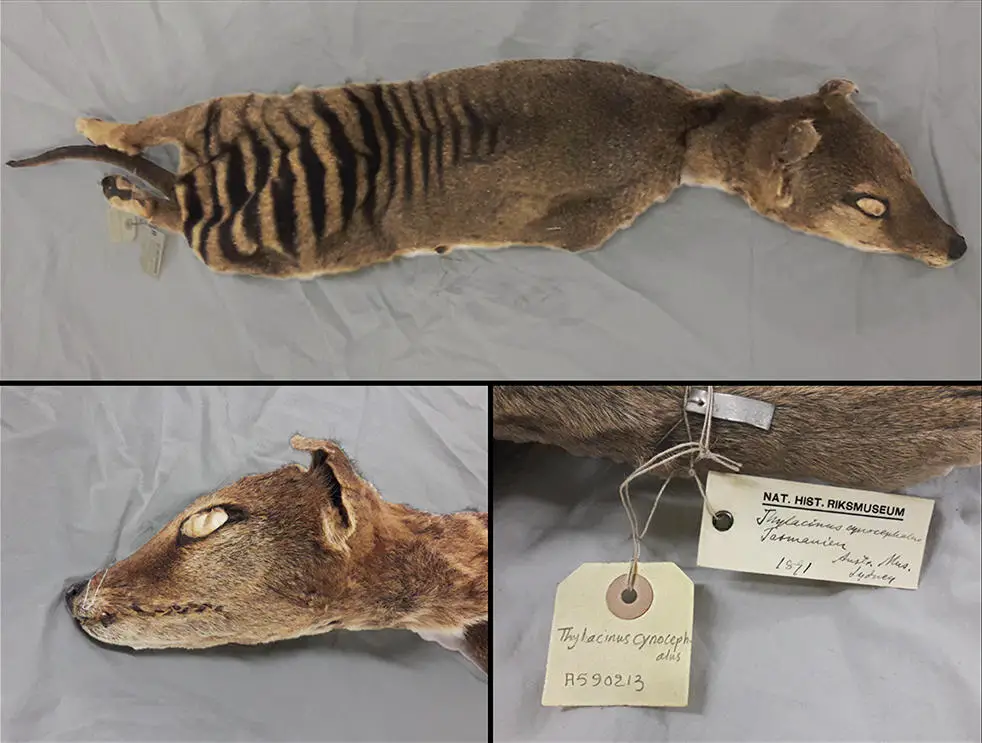The study utilized a Tasmanian tiger specimen that has been maintained in a desiccated state at room temperature within the Swedish Museum of Natural History in Stockholm. Photograph credit goes to Emilio Mármol Sánchez, with editing by Panagiotis Kalogeropoulos.
A groundbreaking study has achieved the isolation and sequencing of RNA molecules that are over a century old from a Tasmanian tiger specimen, preserved in a museum at room temperature. This is the inaugural effort to reconstruct the transcriptomes of skin and skeletal muscle tissues from a species that has gone extinct. The scientific team emphasizes the importance of these findings for worldwide endeavors focused on the resurrection of extinct species, including the Tasmanian tiger and the woolly mammoth, as well as research concerning pandemic RNA viruses.
Photograph credit for Marc R. Friedländer is attributed to Niklas Norberg Wirtén/SciLifeLab.
The Tasmanian tiger, or thylacine, was a unique top-tier carnivorous marsupial that was once found throughout Australia and Tasmania. The species faced its ultimate extinction following European colonization, after being labeled an agricultural nuisance. A bounty of £1 for each mature animal killed was established by the year 1888. The last verified living Tasmanian tiger died in confinement in 1936 at Beaumaris Zoo in Hobart, Tasmania.
Recent de-extinction endeavors have prioritized the Tasmanian tiger, considering that its original habitat in Tasmania remains largely intact. Restoring a living, functional Tasmanian tiger demands not only a full understanding of its genome (DNA) but also insights into the dynamics of tissue-specific gene expression and regulatory mechanisms, information that can only be obtained through transcriptome (RNA) analysis.
Emilio Mármol, the principal investigator of a study recently published in Genome Research by SciLifeLab researchers in partnership with the Centre for Palaeogenetics—a collaborative project between the Swedish Museum of Natural History and Stockholm University—stated, “The complexities involved in reviving species like the Tasmanian tiger or woolly mammoth necessitate a profound comprehension of both genome and transcriptome regulatory mechanisms, insights that are only now coming to light.”
RNA molecules extracted from the Tasmanian tiger
The scientists involved in this research have for the first time sequenced the transcriptome of skin and skeletal muscle tissues from a 130-year-old desiccated Tasmanian tiger specimen, stored at room temperature in the Swedish Museum of Natural History. This led to the identification of gene expression profiles specific to certain tissues that are comparable to those found in living marsupial and placental mammals.
The quality of the recovered transcriptomes was sufficiently high, allowing for the identification of muscle- and skin-specific protein-coding RNAs. It also enabled the annotation of previously unidentified ribosomal RNA and microRNA genes, following guidelines from MirGeneDB.
Marc R. Friedländer, Associate Professor at the Department of Molecular Biosciences, The Wenner-Gren Institute at Stockholm University and SciLifeLab, stated, “For the first time, we have insight into the existence of thylacine-specific regulatory genes like microRNAs that went extinct over a century ago.”
This trailblazing study paves the way for new prospects and implications in the investigation of the extensive array of specimens and tissues that are conserved in museums globally, where untapped RNA molecules may await discovery and sequencing.
Love Dalén, Professor of evolutionary genomics at Stockholm University and the Centre for Palaeogenetics, said, “Looking forward, it might become possible to extract RNA not just from extinct creatures but also RNA virus genomes such as SARS-CoV2 and their ancestral forms from the skin samples of bats and other host organisms stored in museum collections.”
The authors anticipate that the study will catalyze future comprehensive research initiatives that integrate both genomics and transcriptomics, heralding a new epoch in the field of palaeogenetics beyond merely DNA.
Reference: “Historical RNA expression profiles from the extinct Tasmanian tiger” authored by Emilio Marmol-Sanchez, Bastian Fromm, Nikolay Oskolkov, Zoe Pochon, Panagiotis Kalogeropoulos, Eli Eriksson, Inna Biryukova, Vaishnovi Sekar, Erik Ersmark, Bjorn Andersson, Love Dalen, and Marc Friedlander, published on 18 July 2023 in Genome Research.
DOI: 10.1101/gr.277663.123
Table of Contents
Frequently Asked Questions (FAQs) about Extinct Species RNA Sequencing
Q: What is the significance of sequencing century-old RNA from a preserved Tasmanian tiger?
A: The significance lies in it being the first-ever reconstruction of transcriptomes from an extinct species. This breakthrough has implications for de-extinction efforts and research on pandemic RNA viruses.
Q: Why is the Tasmanian tiger of particular interest in de-extinction efforts?
A: The Tasmanian tiger is of interest because its natural habitat in Tasmania is still largely preserved, making it a potential candidate for resurrection. However, achieving this requires a deep understanding of its genome and transcriptome.
Q: What were the key findings of the study on the Tasmanian tiger’s RNA?
A: The study identified tissue-specific gene expression signatures in the century-old RNA, resembling those of living marsupial and placental mammals. It also led to the discovery of muscle- and skin-specific protein-coding RNAs and the annotation of previously unidentified genes.
Q: How might this study impact future research in genomics and transcriptomics?
A: The study opens up new possibilities for exploring specimens and tissues in museums worldwide, potentially uncovering more RNA molecules. It could also enable the extraction of RNA from extinct animals and RNA virus genomes from preserved samples, further advancing genetic research.
Q: Who conducted this groundbreaking research on the Tasmanian tiger’s RNA?
A: The study was conducted by researchers at SciLifeLab in collaboration with the Centre for Palaeogenetics, a joint venture between the Swedish Museum of Natural History and Stockholm University.
More about Extinct Species RNA Sequencing
- Genome Research Journal
- SciLifeLab
- Centre for Palaeogenetics
- Tasmanian Tiger (Thylacine)
- De-Extinction
- RNA Sequencing
- Pandemic RNA Viruses


